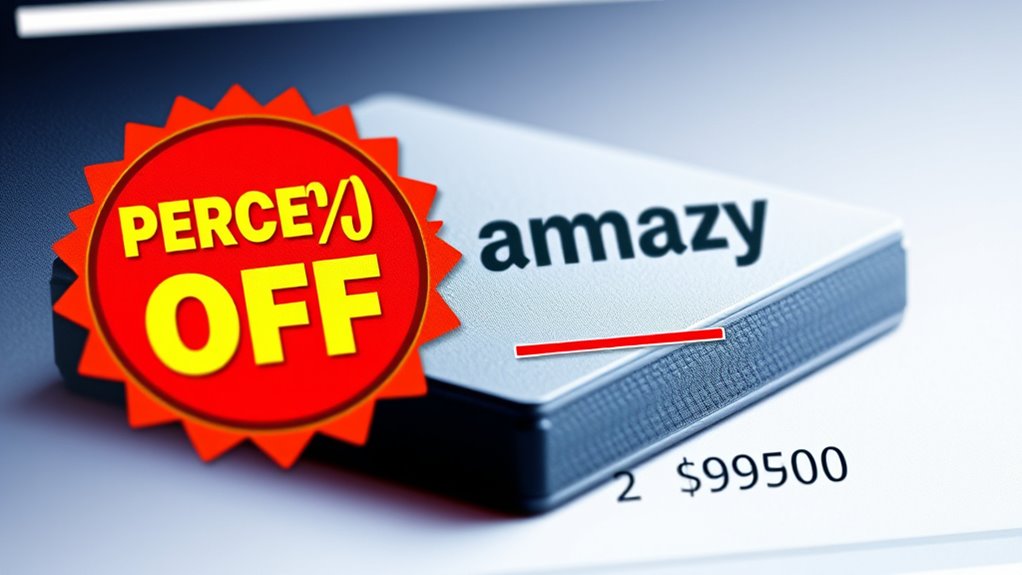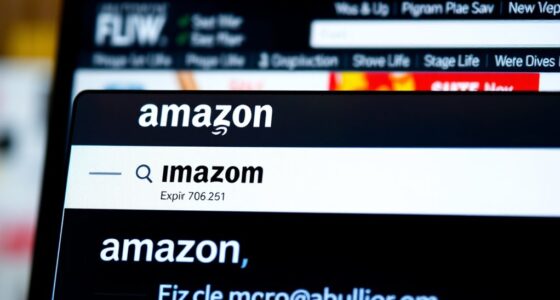When you see a “percent off” on Amazon, it’s often based on an inflated list price rather than the actual market value or typical sale price. This means the discount may look bigger than it really is, creating a false sense of savings. Amazon’s pricing strategies, including fluctuating list prices and promotional fees, can distort the true value of a deal. Keep exploring to learn how these figures can be manipulated and what to watch for.
Key Takeaways
- “Percent off” often compares the sale price to an artificially inflated list price, misleading buyers about actual savings.
- Amazon’s dynamic pricing algorithms can inflate list prices, skewing the perceived discount percentage.
- Promotions may appear substantial but are based on inflated list prices, not true market value.
- The true cost of discounts includes fees, which can significantly reduce profit margins despite high percent-off figures.
- Understanding the difference between list price, market value, and actual discounts helps optimize promotional strategies.

Have you ever wondered how Amazon calculates the true value of a promotion? When you set up a discount, Amazon makes it seem straightforward: you choose a percentage off, and buyers see that percentage displayed prominently. But the actual savings they realize often tell a different story. As a seller, understanding how the “percent off” figure is derived and what it really means can help you better plan your promotions and protect your margins.
First, Amazon calculates the discount percentage based on the original list price versus the promotional price you set. If you offer a 20% discount, buyers will see that percentage, but that figure can be misleading. The original price might have been inflated artificially, or the product could have been priced differently before the promotion. So, the “percent off” often reflects a comparison to the list price, not necessarily what the product would normally sell for in the market. To buyers, it creates an illusion of significant savings, but the actual market value might be quite different. Amazon’s pricing algorithms often influence the list price, which can further skew perceived savings.
Amazon’s “percent off” often compares to inflated list prices, not actual market value, creating a misleading perception of savings.
When you run a promotion, you select start and end dates, and Amazon processes the offer within roughly four hours. You specify the percentage discount, which can be applied to single or multiple SKUs or ASINs. You also have options to exclude certain items, giving you control over which products benefit from the promotion. To keep track of everything, you can add internal descriptions and tracking IDs, helping you analyze the success of each campaign afterward.
However, the true cost of discounts is more complex than just the percentage off. Amazon’s promotional fee structures are changing in 2025, shifting from flat fees to hybrid models that include a daily fee plus a percentage of deal sales, with caps to protect seller profitability. For example, Lightning Deals now involve a daily fee plus 1% of sales, capped at $2,000, making costs more predictable and aligned with actual sales performance. Coupons are also affected: their fees shift from a fixed $0.60 per unit to a combination of a $5 fee plus 2.5% of coupon sales. This new model benefits sellers offering lower-priced items by reducing per-unit costs, but it demands careful budgeting.
When applying coupons, you need to account for both the discount amount and the associated fees. For example, a $1 discount on a $10 item costs you $1.60 under the old fee structure—$1 for the discount and $0.60 for the coupon fee. Post-2025, the costs are different, making it essential to reassess your promotional budgeting strategy. Amazon also displays “percent off” based on original prices, but these figures can be misleading if the list prices were inflated. Real savings depend on actual market prices and historical trends, not just the advertised discount.
Understanding these nuances helps you avoid overestimating the value of your promotions. Platforms like AWS and others often apply discounts after factoring in volume tiers and pricing models, excluding reservation discounts. This helps you estimate actual costs without the influence of commitments or savings plans. By grasping how Amazon calculates and displays discounts, you can tailor your promotions more effectively, balancing volume growth with profitability. Recognizing that the “percent off” may not always reflect true savings allows you to make smarter, more strategic decisions for your business.
Frequently Asked Questions
How Do Amazon’s Discounts Compare to Competitors’ Pricing Strategies?
You notice Amazon’s discounts are more targeted and deeper on fewer products, unlike competitors who offer broader, shallower deals. Amazon uses advanced AI to adjust prices frequently, focusing on high-demand categories like electronics. Meanwhile, competitors rely on scheduled promotions and manual pricing, aiming for volume sales. This strategic difference means Amazon emphasizes precision and margins, forcing you to navigate dynamic pricing, while competitors focus on wide-reaching, less frequent discounts.
Are There Hidden Fees Affecting the Final Price After Discounts?
You should know that hidden fees can impact your final price even after discounts. These include referral, fulfillment, storage, and returns fees, which often aren’t obvious. When you calculate your pricing, you need to account for all these additional costs. Otherwise, you risk underpricing your products and hurting profit margins. Being aware of these hidden fees helps you set more accurate prices and maintain healthy profits.
How Often Do Amazon’s Discount Percentages Change?
Like a clock stuck in the 19th century, Amazon’s discount percentages change constantly. You might see prices update every 10 minutes, with up to 2.5 million changes daily. External factors, competition, and promotions drive these fluctuations, making the discount percentage a dynamic figure. So, if you’re watching for the best deal, remember it’s a moving target—your ideal discount could vanish and reappear in moments.
Does Amazon Apply Discounts to Third-Party Seller Listings Differently?
You might wonder if Amazon treats discounts on third-party seller listings differently. It does—Amazon applies discounts funded by itself, indicated by the “Discount provided by Amazon” tag, and these discounts can be up to around 9%. Importantly, sellers receive the full listing price, and fees are calculated on that amount. Amazon keeps control over discounting, often without sellers’ prior consent, but sellers still profit from full-price sales.
Can Discounts Be Combined With Other Promotional Offers?
You might think discounts are always additive, but Amazon’s policies tell a different story. When you’re running promotions, discounts can often be combined, especially with Lightning Deals, Prime Exclusive Deals, or Best Deals. However, sellers can choose non-stacking coupons to prevent unintended overlaps. Keep in mind, timing and promotion types matter—careful planning helps avoid losing profit or creating confusion, ensuring your discounts work together effectively.
Conclusion
Now that you see through Amazon’s discount tricks, you’re armed with the truth behind the numbers. Don’t let the illusion of big savings blind you—it’s like chasing a mirage in the desert. By understanding the real math, you can make smarter choices and avoid falling into the trap of false discounts. Remember, knowledge is your best tool to navigate the shopping landscape and come out ahead. Stay sharp and shop smart!








